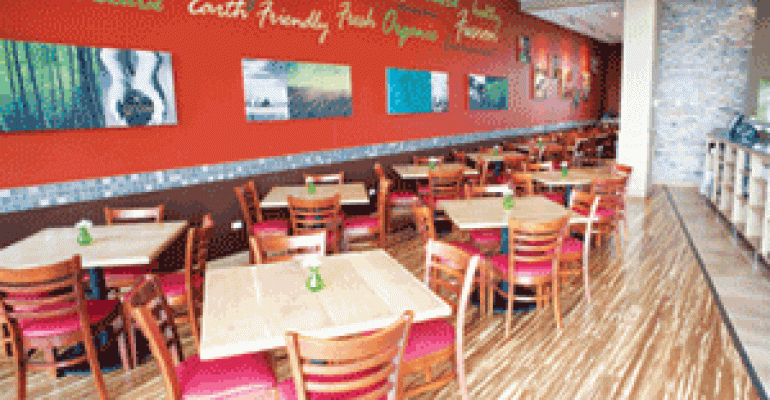Forgive Tom Katsenos if he gushes a bit. Like a brand-new papa bursting with pride, he’s fired up about his 4-month-old Pizza Fusion franchise store in Naperville, Ill., west of Chicago.
It’s apparent on a walk through the eco-friendly, mainly organic pizzeria as he shows off artisan pizzas baking on heat-retaining soapstone decks in a rotary oven, and explains why LED downlights, Energy Star equipment, rubberwood chairs and bamboo flooring reduce his carbon footprint.
“One of the things I enjoy most is showing people around,” Katsenos said. “Teachers from elementary schools call me to set up field trips. High school students have interviewed me for ideas on making their cafeteria more energy efficient.”
The 2,000-square-foot, 50-seat eatery, which has words like “fresh,” “healthy” and “natural” painted on its dining room wall, might be the greenest store in the Fort Lauderdale, Fla.-based company. That’s saying something, given Pizza Fusion’s sustainability mission. It claims to be the only restaurant chain to build all of its stores to LEED, or Leadership in Energy and Environmental Design, specifications set by the U.S. Green Building Council.
Its LEED-certified locations save 30 percent on utility expenses due to their green practices. The company has a list of three dozen environmental initiatives it follows, ranging from delivering food in hybrid vehicles to insulating buildings with recycled blue jeans to using dual-flush, low-flow toilets to save water.
Katsenos has worked in restaurants for more than two decades, most recently a 12-year stint as the independent owner of a suburban Chicago casual-dining place. He sold that business prior to joining the Pizza Fusion system, which now numbers 20 units with five more opening this year, convinced that clean food and sustainability are the future of the industry.
“The more I learned about it, the more I got into it,” said Katsenos, recalling the meeting he and his wife had with concept founders Vaughan Lazar and Mike Gordon. “We felt their passion and really loved the idea. We came back home eager to find the right location.”
The perfect spot turned out to be a new retail development in Naperville designed to LEED standards with a Whole Foods natural-foods supermarket as an anchor tenant.
The key to the concept’s signature pizzas, which are available on organic white, multigrain and gluten-free crusts with a variety of vegetable and meat toppings, is a Roto-Flex rotating deck oven with a lighted interior and sliding-glass doors. The 37-cubic-foot, gas-powered oven is responsible for hot sandwiches, brownies and cookies as well as pizza. Dialed up to 525 degrees Fahrenheit, it produces a pie in about seven minutes. It is the sole piece of cooking equipment.
“We have no grills, no fryers, not even a microwave,” Katsenos said.
The oven has four rotating soapstone decks, which retain heat for crisp crust formation. The fact that the decks rotate horizontally not only ensures even baking of products — there are no hot spots — it also allows the top deck to be reserved for baking gluten-free pizzas, thus avoiding cross-contamination with other pies.
That’s important because some Pizza Fusion customers have special health needs, such as celiac disease sufferers, who are sensitive to the gluten in conventional baked goods, and vegans, in addition to the many who simply like good pizza.
“I’ve had people crying in here because this is the first time they have been able to eat pizza in years,” Katsenos said. “We’ve had customers drive all the way from Chicago to have our vegan pizza.”
Rounding out the streamlined equipment package are a 60-quart Hobart mixer, dough sheeter, pizza make table, walk-in cooler with extensive insulation and energy-saving compressor, ice machine and compact dish machine.
Most everywhere you look, there’s an earth-friendly feature, from rubberwood chairs made from rubber trees harvested after their latex-producing cycle ends to flooring made of bamboo, a fast-growing, self-generating wood.
Also noteworthy are Energy Star-certified LED — light-emitting diode — downlights. They cost more than light bulbs, Katsenos concedes, but are significantly more efficient in the long run. Each solid-state fixture uses less than 14 watts and is expected to shine for 50,000 hours.
“A lot of restaurants are putting in CFLs [compact fluorescent lights],” Katsenos said. “But I took it to the next step. I wanted to do even more.”

